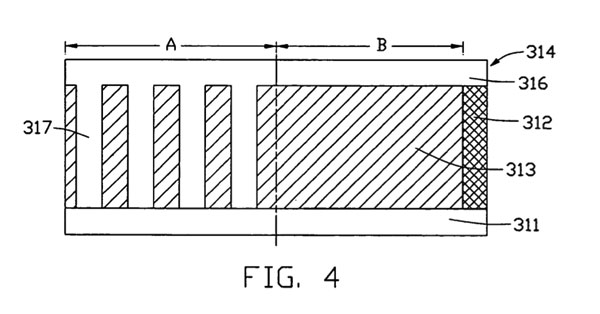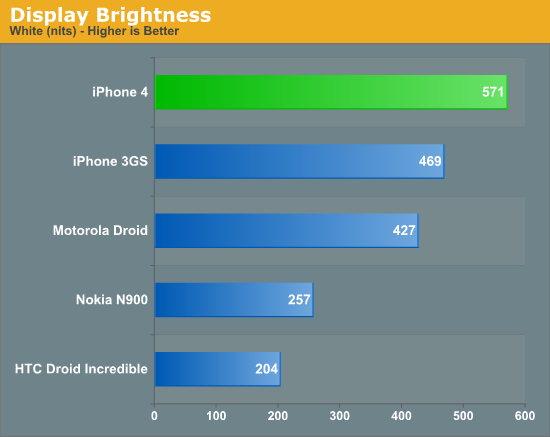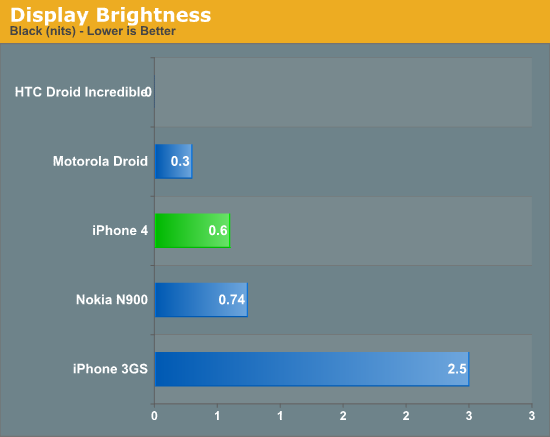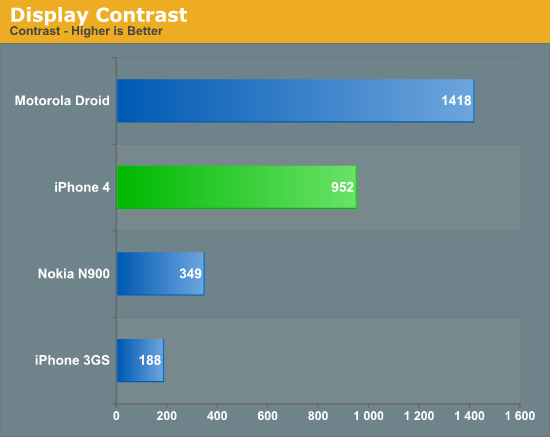Apple's iPhone 4: Thoroughly Reviewed
by Brian Klug & Anand Lal Shimpi on June 30, 2010 4:06 AM EST- Posted in
- Smartphones
- Apple
- iPhone 4
- Gadgets
- Mobile
More Display
It's obvious how Apple settled on 960x640; it's four times the resolution of the previous iPhones. However, instead of decreasing text size, iOS 4 scales appropriately, and the size of everything remains the same. The result is that there are small details everywhere that pop out. Apple's icons on the home screen are the first that really pop out, and new iOS 4 optimized applications will bring that increased detail as developers add higher resolution artwork.
The display panel itself uses a subset of IPS (In Plane Switching) display technology called Fringe Field Switching (FFS). Where IPS switches the crystal polarization in the plane of the display with two opposing electrical substrates composed of semi opaque metals (which decreases transmission and viewing angles), FFS uses considerably less metal by arranging the electrodes in a comb like structure.

See that - it almost looks like a comb. Or an impulse train. Or Dirac comb. So many combs.
The result is that there's considerably less metal in back and in front of the pixel, resulting in much higher transmission of light through the display, and higher brightness for a given backlight level. Using FFS to drive pixel switching is critical here because of the high dot pitch in the iPhone 4's display.
The other interesting difference between iPhone 4's retina display and previous displays is that the digitizer is in optical contact with the display itself. There's no longer an air gap, and as a result, no longer any opportunity for dust to gradually work its way inbetween. Over time, I've noticed a few dust specks creep in on my 3GS, it does happen. The digitizer and display panel are essentially laminated together. The added benefit is that fewer material interfaces results in fewer internal reflections - think the "super" in Super AMOLED but applied to TFT. That's what Apple has done here.
Apple is using Corning's Gorilla glass which touts hugely increased scratch resistance and robustness. Both the front and back of the iPhone 4 are that same type of glass. I've noticed a few superficial scratches (called sleeks) that have appeared on the back, but really the true test will be how the phone looks after 6 months in the pocket. It's interesting that the iPhone capacity markings have disappeared from the back of the phone - no doubt this was done so Apple could make one part and one part only for each color.
The rest of the details are in the specifications. Apple advertises increased brightness of 500 nits and a contrast ratio of 800:1. We measured, and our iPhone 4 exceeded specs at 571 nits and just under 1000:1 contrast ratio.



Note that the HTC EVO 4G is missing as Anand has it, but it's on its way to me. As soon as I get it, I'll measure display brightness, black point, and contrast and update these results. In addition, the HTC Droid Incredible (and thus Nexus One) contrast is effectively infinity by the way we calculate, due to pixels being completely turned off in the black state. In addition, I'm led to believe that the AMOLED's PenTile grid throws off our numbers when measuring brightness. I've run and rerun this test, it keeps coming up that way.
Next to the iPhone 4, the 3GS display really shows its age. It leaks light when displaying black, with an absurdly high black point of nearly 3 nits. Just looking at the lock screen on the iPhone 4 next to the 3GS it's readily apparent how much better blacks are. iPhone 4 easily bests the 3GS but still isn't quite as contrasty as the Incredible or Nexus One AMOLED displays, or the IPS in the Motorola Droid. You do get higher resolution and brightness, however, but nothing is free.
Going from the iPhone 4's display back to the 3GS is pretty painful, but going back to even relatively high dot pitch displays on the desktop is painful as well. Even on the "high resolution" MacBook Pro with 1680x1050 display, displaying an iPhone 4 screenshot at native resolution uses up 91% of the height. If there's one thing I hope the iPhone 4 display does, it's generate demand for 300 PPI level desktop displays - the era of 110 PPI displays being the norm needs to end now.










270 Comments
View All Comments
Brian Klug - Wednesday, June 30, 2010 - link
I've read your commentary but don't see how we're in disagreement, about anything to be honest. I know for a fact that Apple is reporting RSSI (signal strength) in dBm and not using SNR. You'll just have to trust me that this is the case ;). This is entirely the point of the section - to illustrate just how useless that metric is especially in the case of the iPhone 4, and how much they need to use a different quality metric like CQI.In addition, this: "Because cellular carriers don't want clients to see less than 5 bars, so they have been pretty much rigged to display 5 bars in most situations until the signal is VERY BAD."
Is exactly what I've stated, a few times in so many words in the article. In fact, it's that kind of blatant lying about the dynamic range which makes this effect even more exacerbated. I realize that carriers have a vested interest in making the network look great everywhere - but turns out this ended up biting apple back with the iPhone 4 for reasons I stated.
I agree that normally -107 dBm of signal is bad, but have reason to believe that the iPhone 4's baseband deals just fine with the link even at that signal. Definitely grab someone's iPhone and try it out at -107 and -113; the amount of success I've had is unparalleled compared to other UMTS handsets I've played with.
-Brian
fhaddad922 - Wednesday, June 30, 2010 - link
The subject says it all, but I'll type it again for the slow.If you have any type of "smart" phone (I have no idea whats so "smart" about it) and you are paying $100+ per month to use it, you are really dumb. The only smart people are the ones that convinced you to buy this crap!
Now, if you are some type of a business owner and you need to keep in contact with employees or customers or something similar, than by all means, purchase one of these phones and use it.
But for the rest of the world (which is probably 90% of the readers here), why the f**k do you need a $100+ / month plan?
The phone does nothing that you need. Stop making the cell phone companies richy.
They talk about how good the camera is on it... IT SUCKS!
They talk about how good the video is on it... IT SUCKS!
They talk about how you have to hold the phone the right away... I bet one of the designers said "oops"
FaceTime.. lawl... really?
They are already gouging their customers. For example, to charge $0.25 to send a text message is asinine. It's not even $0.50 to put a letter in the mail and mail it across the country. How do they justify $0.25 to send a text message? On top of that, for $50.00 / month and you don't get unlimited calling. Thats dumb.
strikeback03 - Thursday, July 1, 2010 - link
Thank you for the anti-capitalist rantpetzi-bear - Wednesday, June 30, 2010 - link
Have you tried it with a glove?Should be easier that applying a thin film.
I thinking about clear coating the frame :-)
But a.) I am right handed
b.) I couldn't get my hands a phone yet - still sold out
Brian Klug - Wednesday, June 30, 2010 - link
Very good point, I'll try that too!-Brian
MonkeyPaw - Wednesday, June 30, 2010 - link
Actually, you might have more issues with the "touch of death" if you are right-handed. I'm a righty, and I hold cell's in my left hand all the time so that I can free my dominant hand for things like writing or mouse clicking.Personally, the iPhone4 is a nice step up, but I really question the design choices. Glass on both sides? A non-coated metal rim that doesn't like human touch? Serious engineering flaws for an otherwise well-designed device.
Brian Klug - Wednesday, June 30, 2010 - link
See this is exactly how I end up holding the phone. I hold it in my left hand (the wrong way) and use the right hand to tap, select, e.t.c.-Brian
vol7ron - Wednesday, June 30, 2010 - link
Trying with a glove would be interesting, since around here summers are hot and winters are cold (glove worthy).I was suggesting the film because many people I know use it because it makes the phone more pocket-worthy. Using a hard plastic case, or even a silicone case, provides unnecessary bulk, which is uncomfortable when wearing those stylish tight new pants -ha.
jasperjones - Wednesday, June 30, 2010 - link
usually i find something to criticize but not today. excellent review. that is it.jasperjones - Wednesday, June 30, 2010 - link
Actually I found something.The battery life figures for the Nexus One were simply copied from the original Nexus One review (when the phone ran 2.1/Eclair). This doesn't make sense as you updated all other figures (performance etc.) to reflect FroYo.
FroYo has much improved battery life on my Nexus One.